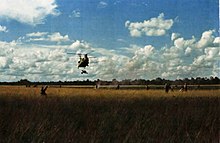
The Army of the Republic of Vietnam composed the ground forces of the South Vietnamese military from its inception in 1955 to the Fall of Saigon in April 1975. At the ARVN's peak, an estimated 1 in 9 citizens of South Vietnam were enlisted, composed of Regular Forces and the more voluntary Regional Forces and the Popular Force militias. It is estimated to have suffered 1,394,000 casualties during the Vietnam War.

The Cambodian campaign was a series of military operations conducted in eastern Cambodia in mid-1970 by South Vietnam and the United States as an expansion of the Vietnam War and the Cambodian Civil War. Thirteen operations were conducted by the Army of the Republic of Vietnam (ARVN) between April 29 and July 22 and by U.S. forces between May 1 and June 30, 1970.
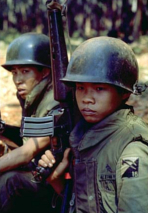
The Battle of Xuân Lộc was the last major battle of the Vietnam War that took place at Xuân Lộc, Đồng Nai Province. Over a period of twelve days between 9 and 21 April 1975, the outnumbered South Vietnamese reserves attempted to stop the North Vietnamese forces from overrunning the town and breaking through towards South Vietnam's capital, Saigon. The Army of the Republic of Vietnam (ARVN) committed almost all their remaining mobile forces, especially the 18th Division, under Brigadier General Lê Minh Đảo, to the defence of the strategic crossroads town of Xuân Lộc, hoping to stall the People's Army of Vietnam (PAVN) advance. The battle ended when the town of Xuân Lộc was captured by the PAVN 4th Army Corps led by Major General Hoàng Cầm.

Operation Attleboro was a Vietnam War search and destroy operation initiated by the 196th Light Infantry Brigade with the objective to discover the location(s) of People's Army of Vietnam (PAVN) and Viet Cong (VC) base areas and force them to fight. The operation was named after Attleboro, Massachusetts, where the brigade had been formed. Operation Attleboro grew to be the largest series of air mobile operations to that time, involving all or elements of the 196th Brigade, 25th Infantry Division, 1st Infantry Division and a brigade of the 4th Infantry Division, as well as numerous Army of the Republic of Vietnam and Regional Forces/Popular Forces and Nùngs. In the end, the operation became a Corps operation commanded by II Field Force, Vietnam.

The Battle of Lộc Ninh was a major battle fought during the Easter Offensive during the Vietnam War, which took place in Bình Long Province, South Vietnam between 4 and 7 April 1972. Towards the end of 1971, North Vietnamese leaders decided to launch a major offensive against South Vietnam, with the objective of destroying Army of the Republic of Vietnam (ARVN) units and capturing as much territory as possible, in order to strengthen their bargaining position in the Paris Peace Accords. On 30 March 1972, two People's Army of Vietnam (PAVN) divisions smashed through the Vietnamese Demilitarized Zone, marking the commencement of the Easter Offensive. They quickly overwhelmed South Vietnamese units in the I Corps Tactical Zone. With the rapid collapse of South Vietnamese forces in the northern provinces of South Vietnam, PAVN and Viet Cong (VC) forces began preparing for their next offensive, targeting Bình Long Province in the rubber plantation region north of Saigon. On 4 April, the VC 5th Division opened their attack on Lộc Ninh, defended by the ARVN 9th Infantry Regiment. After three days of fighting, the vastly outnumbered ARVN forces, though well supported by American air power, were forced to abandon their positions in Lộc Ninh.

The 18th Division was an infantry division in the III Corps of the Army of the Republic of Vietnam (ARVN). The U.S. Military Assistance Command Vietnam considered the 18th as undisciplined and was well known throughout the ARVN for its "cowboy" reputation. In 1975 the 18th was made famous for its tenacious defense of Xuân Lộc, the last major battle before the Fall of Saigon.

The First Battle of Loc Ninh took place during the Vietnam War that occurred between 29 October and 7 November 1967, fought by the Viet Cong, Army of the Republic of Vietnam (ARVN), Civilian Irregular Defense Group and the United States Army.

The Fifth Division of the Army of the Republic of Vietnam (ARVN)—the army of the nation state of South Vietnam that existed from 1955 to 1975—was part of the III Corps that oversaw the region of the country surrounding the capital, Saigon.
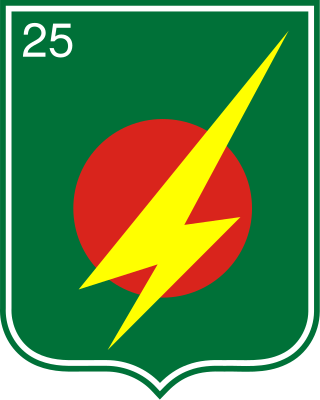
The 25th Division of the Army of the Republic of Vietnam (ARVN)—the army of the nation state of South Vietnam that existed from 1955 to 1975—was part of the III Corps that oversaw the region of the country surrounding the capital, Saigon. It was based at Củ Chi Base Camp to the northwest of the city.

The Vietnamese Airborne Division or VNAD was one of the earliest components of the Republic of Vietnam Military Forces. The Vietnamese Airborne Division began as companies organized in 1948, prior to any agreement over armed forces in Vietnam. After the partition of Vietnam, it became a part of the Army of the Republic of Vietnam. This division had its distinct origins in French-trained paratrooper battalions, with predecessor battalions participating in major battles including Dien Bien Phu and retained distinct uniforms and regalia. With the formation of an independent republic, the colonial paratroopers were dissolved, however regalia and aesthetics alongside the nickname "Bawouans" would be retained.
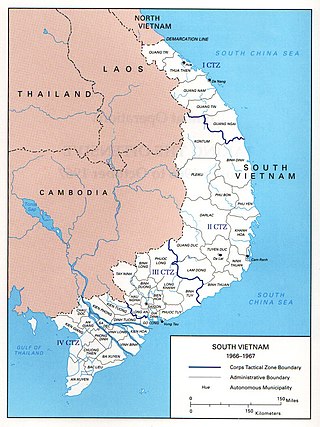
At the beginning of 1966, the number of U.S. military personnel in South Vietnam totaled 184,300. South Vietnamese military forces totaled 514,000 including the army (ARVN) and the Regional Force and Popular Force militias. The North Vietnamese People's Army of Vietnam (PAVN) numbered 400,000, most still in North Vietnam. 50,000 PAVN cadre and soldiers infiltrated South Vietnam during 1965. Group 559, charged with transporting supplies down the Ho Chi Minh Trail to supply PAVN troops in both South Vietnam and Laos, numbered 24,400 personnel. The U.S. estimated the number of Viet Cong (VC) and PAVN soldiers in South Vietnam at nearly 280,000 by June 1966, including part-time guerrillas. A pause in the bombing of North Vietnam by U.S. warplanes had been announced by President Johnson on 24 December and remained in effect.

Tây Ninh Combat Base is a former U.S. Army and Army of the Republic of Vietnam (ARVN) and current People's Army of Vietnam (PAVN) base west of Tây Ninh in southern Vietnam.
Operation El Paso and Operation El Paso II were operations conducted during the Vietnam War by the U.S. Army's 3rd Brigade of the 1st Infantry Division in Bình Long Province, lasting from 19 May to 13 July 1966.
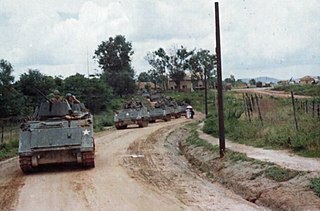
Operation Diamond Head was an operation conducted by the 3rd Brigade, 25th Infantry Division in Tây Ninh Province, lasting from 11 July to 31 October 1967.

Operation Yellowstone was an operation conducted by the 1st and 3rd Brigades, 25th Infantry Division in northeast Tây Ninh Province, lasting from 8 December 1967 to 24 February 1968.
Operation Quyet Thang, was a United States Army and Army of the Republic of Vietnam (ARVN) security operation to reestablish South Vietnamese control over the areas immediately around Saigon in the aftermath of the Tet Offensive. The operation started on 11 March 1968 and ended on 7 April 1968.
Operation Shenandoah II was a security operation conducted during the Vietnam War by the U.S. 1st Infantry Division to secure and repair Highway 13, South Vietnam from 29 September to 19 November 1967.
Phase III of the Tet offensive of 1968 was launched by the People's Army of Vietnam (PAVN) and Viet Cong (VC) from 17 August to 27 September 1968. The offensive was divided into two waves of attacks from 17 to 31 August 1968 and from 11 to 27 September of that same year.
The War of the flags was a phase of fighting throughout South Vietnam lasting from 23 January to 3 February 1973 as the forces of North and South Vietnam each sought to maximize the territory under their control before the ceasefire in place agreed by the Paris Peace Accords came into effect on 27 January 1973. The fighting continued past the ceasefire date and into early February. South Vietnamese forces made greater territorial gains and inflicted significant losses on the North Vietnamese forces.

Operation Kole Kole was a search and destroy operation during the Vietnam War conducted by the 2nd Brigade, 25th Infantry Division that took place in Hậu Nghĩa and Tây Ninh Provinces, lasting from 14 May to 7 December 1967.
